DOMED CITY (1:160 scale) WIP
- Thread starter Peter54
- Start date
Peter54
Well-Known Member
- Joined
- Sep 17, 2022
- Messages
- 217
Have always been fascinated by the teleporter ever since seeing the 1958 horror movie "The Fly".

Recently been rethinking how to simply simulate it. Star Trek version of dematerialization into atoms gave me the idea of 'blurring' the image.
I know that the human nervous system cannot respond to impulses above 2,000 pulses per second. Perhaps visual light pulses/flashes at that frequency may seem to blur to a point of no longer distinguishing between flashes. If so, then a rotating cylinder, half white, half black, at 2,000 rpm ought to look grey.
Here is my doodling on the subject...
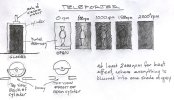
The next question is how to make the 'open' teleporter doorway, at rest, show no figure standing inside.
Another option came to mind while watching reruns of The Munsters. In the TV series, in season 2 episode16 - 'Herman Picks a Winner', the opening scene shows a funny vanishing cabinet trick.
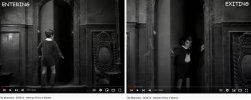
This would be simpler to simulated...
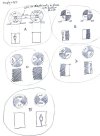
Perhaps teleporting from one building entrance to another at the other end of the diorama.

Recently been rethinking how to simply simulate it. Star Trek version of dematerialization into atoms gave me the idea of 'blurring' the image.
I know that the human nervous system cannot respond to impulses above 2,000 pulses per second. Perhaps visual light pulses/flashes at that frequency may seem to blur to a point of no longer distinguishing between flashes. If so, then a rotating cylinder, half white, half black, at 2,000 rpm ought to look grey.
Here is my doodling on the subject...

The next question is how to make the 'open' teleporter doorway, at rest, show no figure standing inside.
Another option came to mind while watching reruns of The Munsters. In the TV series, in season 2 episode16 - 'Herman Picks a Winner', the opening scene shows a funny vanishing cabinet trick.

This would be simpler to simulated...

Perhaps teleporting from one building entrance to another at the other end of the diorama.
urumomo
Well-Known Member
- Joined
- Mar 18, 2013
- Messages
- 7,777
2 kHz ?
I doubt you'd need anywhere close to that .
60 Hz is supposedly the visual maximum limit in humans but it's probably a lot less for most ( although I hear dogs can see my LED Christmas lights flashing on AC current ) so IDK what frequency the colors will meld .
I'm eager to see the results of your experiment !
... is this what all that No Doze did to you ? lol
I doubt you'd need anywhere close to that .
60 Hz is supposedly the visual maximum limit in humans but it's probably a lot less for most ( although I hear dogs can see my LED Christmas lights flashing on AC current ) so IDK what frequency the colors will meld .
I'm eager to see the results of your experiment !
... is this what all that No Doze did to you ? lol
Peter54
Well-Known Member
- Joined
- Sep 17, 2022
- Messages
- 217
Visual cones and rods of the eye is different to normal nerves and their response rate may also be different. But as you said, the experiments will reveal what is what.2 kHz ?
I doubt you'd need anywhere close to that .
60 Hz is supposedly the visual maximum limit in humans but it's probably a lot less for most ( although I hear dogs can see my LED Christmas lights flashing on AC current ) so IDK what frequency the colors will meld .
I'm eager to see the results of your experiment !
... is this what all that No Doze did to you ? lol
Long ago I built a pulse width modulator in conjunction with a variable frequency oscillator to meld LED colours through crystals. I will have a look to see if I still have my notes on that. I still have the unit though. I will get back to you on that later today.
Peter54
Well-Known Member
- Joined
- Sep 17, 2022
- Messages
- 217
Well, I looked everywhere but could not find the actual circuit diagram. It was first put together back in 2001, before I had a PC to draw up circuits and store them. But I did find a block diagram drawing and a photo of the built circuit.
The crystal used is clear quartz, and it was used for healing body chakra points; each having its own colour frequency harmonic.
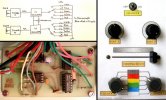
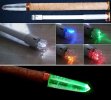
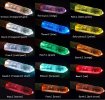
Nevertheless, I am sure I will be re-exploring this circuit sometime in this diorama build.
The crystal used is clear quartz, and it was used for healing body chakra points; each having its own colour frequency harmonic.



Nevertheless, I am sure I will be re-exploring this circuit sometime in this diorama build.
Peter54
Well-Known Member
- Joined
- Sep 17, 2022
- Messages
- 217
I'll have to get back to you about that. My instrument box is stored away in the garage somewhere, and then I'll have to diagnose its output signal.
When I do this, I might as well reverse engineer the circuit board to come up with the circuit diagram I lost.
When I do this, I might as well reverse engineer the circuit board to come up with the circuit diagram I lost.
Peter54
Well-Known Member
- Joined
- Sep 17, 2022
- Messages
- 217
Found the device and drew up a cct diagram for it. The PWM is set at 2.7kHz.

Showing how the PWM works.
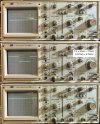
The circuit diagram. While drawing this first draft I remembered certain aspects of its design. I do remember altering the RC components to a point where I no longer saw any flickering. I did not record what that frequency was, but after hooking up the CRO to it today I discover that it is set at about 2.7kHz.
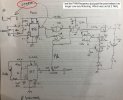

Showing how the PWM works.

The circuit diagram. While drawing this first draft I remembered certain aspects of its design. I do remember altering the RC components to a point where I no longer saw any flickering. I did not record what that frequency was, but after hooking up the CRO to it today I discover that it is set at about 2.7kHz.

Peter54
Well-Known Member
- Joined
- Sep 17, 2022
- Messages
- 217
For those that may need an explanation on how to meld colours.
First of all, having say a red LED and blue LED next to each other, even against a white styrene screen edge, won't show a purple screen, but mostly a red and a blue portion of screen colour. The best way to meld the two is optically. That is, to have a red LED ON to make a red screen while the blue LED is OFF, and vice versa. Having both alternating red/blue/red/blue... at a rate where the eye cannot see any flicker between red and blue causes our brain to see both red and blue together as purple (melded). So, in reality, the colours don't meld, but only appear that way.
Having both the red and blue LED share equal amount of ON and OFF time is called 50% duty cycle. However, if the duty cycle changed by say 25% Red and 75% Blue, then the screen will look a bluish purple (like violet/indigo). Or if the cycle was 75% 25% then the screen will look a redish purple (like magenta). The electronic circuit for changing the duty cycle is called a Pulse Width Modulator (PWM).

But that is not the end of it. Normally, say during a 25% 75% duty cycle, the red LED is ON 25% of the time and OFF 75% of the time. To get the blue LED to take up the 75% ON time, both LEDs need to flip-flop between each transition of the cycle so that there is no period of no light (OFF). In the circuit diagram above, a series of logic gates follow the PWM circuit. They create the flip-flop between the LEDs at the exact rate and timing of the PWM.
First of all, having say a red LED and blue LED next to each other, even against a white styrene screen edge, won't show a purple screen, but mostly a red and a blue portion of screen colour. The best way to meld the two is optically. That is, to have a red LED ON to make a red screen while the blue LED is OFF, and vice versa. Having both alternating red/blue/red/blue... at a rate where the eye cannot see any flicker between red and blue causes our brain to see both red and blue together as purple (melded). So, in reality, the colours don't meld, but only appear that way.
Having both the red and blue LED share equal amount of ON and OFF time is called 50% duty cycle. However, if the duty cycle changed by say 25% Red and 75% Blue, then the screen will look a bluish purple (like violet/indigo). Or if the cycle was 75% 25% then the screen will look a redish purple (like magenta). The electronic circuit for changing the duty cycle is called a Pulse Width Modulator (PWM).

But that is not the end of it. Normally, say during a 25% 75% duty cycle, the red LED is ON 25% of the time and OFF 75% of the time. To get the blue LED to take up the 75% ON time, both LEDs need to flip-flop between each transition of the cycle so that there is no period of no light (OFF). In the circuit diagram above, a series of logic gates follow the PWM circuit. They create the flip-flop between the LEDs at the exact rate and timing of the PWM.
the Baron
Ich bin ja, Herr, in Deiner Macht
- Joined
- May 12, 2009
- Messages
- 2,278
I always think of Isaac Asimov's short story, "It's Such a Beautiful Day".Have always been fascinated by the teleporter ever since seeing the 1958 horror movie "The Fly"...
Similar threads
- Replies
- 2
- Views
- 276
- Replies
- 11
- Views
- 871
Latest posts
-
-
-
thinning tamiya bottle paints for airbrushing
- Latest: styrenemachine
-
-
-
-
-

